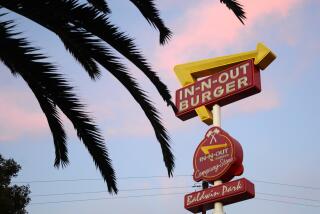Sir Speedy Hopes to Copy Its Success With Print Shops in Spain, Portugal
- Share via
LAGUNA HILLS — When Luis Fernandez returned to his native Spain after working in the United States for six years, he took back to his country the idea of using an outside company to do in-house printing.
Fernandez, a finance manager for Procter & Gamble Co., had to buy printing and photocopying equipment from manufacturers in the United States, Japan or Germany. Like many other European business people, he had to pay costly shipping and tariff fees, then hire operators to use the equipment. These costs can be prohibitive for many small- and medium-size businesses.
Last month, Fernandez decided to turn his printing problems into potential profits. He completed negotiations with Sir Speedy Inc., the Laguna Hills-based quick-printing franchise, to open 50 centers in Spain and Portugal in the next decade.
After a decade of rapid expansion--mostly in the United States--Sir Speedy hopes to duplicate its success in other parts of the world. Fernandez’s franchise is one of many international stores that Sir Speedy plans to open in the next few years of ambitious overseas expansion.
“We’re still growing. Right now, the international market is red hot,” said Don Lowe, president and chief executive of Sir Speedy.
The fast-food industry produced the first wave of franchises to spread across Europe, said Lowe, who added: “Ten years later, we have business service-oriented companies moving out there.”
Sir Speedy already has 17 franchise stores throughout Canada and Hong Kong. By late June, Lowe said, Sir Speedy will reach into Latin America when it opens a franchise store in Bogota, Colombia. The firm recently signed a deal to open 25 centers throughout Colombia.
Lowe, who joined Sir Speedy as president nine years ago, said small- and medium-size businesses in Latin America, unlike their U.S. counterparts, generally have not used printed materials to market their companies or communicate with employees.
“We are much more progressive businessmen in America,” he said. “We put out a lot of leaflets, brochures and catalogues. Latin American businesses have just been doing without.”
Overseas expansion is not without problems. Lowe said contractual snafus often arise, so it can sometimes be difficult to take currencies out of a particular country.
“The government red tape is a little more restricted than where we live,” he said.
Also, Lowe said, in contrast with the United States, just a small percentage of Latin Americans have enough money to open their own businesses, because of the region’s demographics.
“There’s not a dominant middle class,” Lowe said. “They’re either rich or poor, in most cases. That means Sir Speedy will have a smaller market group but won’t find it entirely impossible to build a franchise.”
Although Sir Speedy sees more room for growth in the United States, the company sees even greater promise in Europe and South America, Lowe said.
Many businesses in these countries are caught in a kind of no-man’s-land between commercial printers and their own in-house print shop. Smaller businesses, in general, could not afford either option in order to compete with “the big guys,” Lowe said.
In the United States, “the quick-printing industry has matured rather than become saturated,” said Bob Hall, editor of Quick Printing magazine in Port St. Lucie, Fla. “However, you can’t open a shop on any street corner and be successful. Operators need to be more involved with advertising and direct sales.”
Despite the proliferation of print shops in this country, Lowe estimated that there are more than 500 possible U.S. franchise sites. He said the prime areas are in the Midwest and South.
During the 1980s, Sir Speedy grew three times as fast as the rest of the industry. Sir Speedy’s royalties from franchisees grew from $3.9 million in 1980 to $13.5 million in 1989, while pretax income grew from $700,000 to $5.1 million during the same period. The number of franchise stores soared from 269 to 865; sales at all franchise outlets grew from $38 million to $300 million.
Today, the $6-billion industry has about 26,000 quick printers in the United States, about 25% of which are franchise operations, according to the Chicago-based National Assn. of Quick Printers. While the industry still caters to customers who are pressed for time, new technology has enabled quick-print centers to expand services to include fax machines and personal computers for desktop publishing.
Sir Speedy, which has 24 centers in Orange County, is larger--based on total sales--than its biggest competitor, Agoura Hills-based Postal Instant Press Inc. But PIP has more franchises--about 1,100.
Though in recent years Sir Speedy has grown quickly and remained profitable at the same time, that wasn’t always the case. The company got off to a rocky start in the early 1970s, when management tried to stimulate growth faster than the firm could handle, Lowe said. By 1974, the company was bankrupt. It re-emerged from bankruptcy months later, only to find itself back in bankruptcy court in 1976.
In 1977, KOA Holdings Inc., the Montana-based campground operator and financial services firm, bought a 77% stake in Sir Speedy and guided the company out of bankruptcy. KOA has been sole owner of the company since 1981.
More to Read
Inside the business of entertainment
The Wide Shot brings you news, analysis and insights on everything from streaming wars to production — and what it all means for the future.
You may occasionally receive promotional content from the Los Angeles Times.










